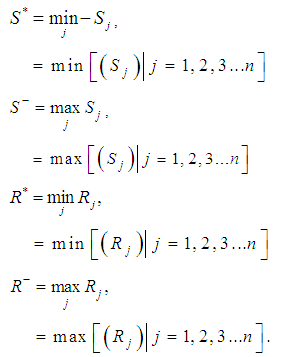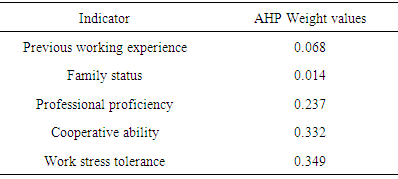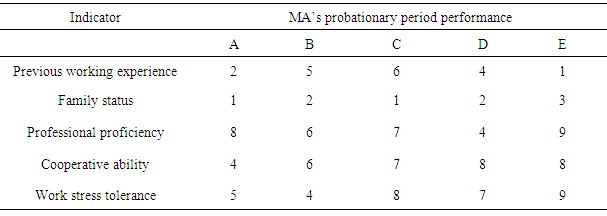-
Paper Information
- Next Paper
- Paper Submission
-
Journal Information
- About This Journal
- Editorial Board
- Current Issue
- Archive
- Author Guidelines
- Contact Us
American Journal of Economics
p-ISSN: 2166-4951 e-ISSN: 2166-496X
2015; 5(5): 463-466
doi:10.5923/j.economics.20150505.03
Applying VIKOR Technique in the Evaluation of Management Associate Work Performance for Small and Medium Enterprises
Kuo-Yan Wang
Xiamen University Tan Kah Kee College, P.R.C.
Correspondence to: Kuo-Yan Wang , Xiamen University Tan Kah Kee College, P.R.C..
| Email: |  |
Copyright © 2015 Scientific & Academic Publishing. All Rights Reserved.
Since investment in employee education and development represents a significant capital expenditure, the recruitment of employees whose personal characteristics, professional skills and abilities meet the required standards is an important aspect of business management. In small and medium enterprises selecting appropriate individuals to fill management positions represents a significant challenge. This paper focused on a case study utilizing the data of five management trainees using an multiple criteria decision-making method (MCDM)-VIKOR technique- to determine the probability of retaining management associates. Several surprising results were obtained. Implications for win-win employee-employer relations and practice are discussed.
Keywords: Employee retention, VIKOR, Management associate, Work performance
Cite this paper: Kuo-Yan Wang , Applying VIKOR Technique in the Evaluation of Management Associate Work Performance for Small and Medium Enterprises, American Journal of Economics, Vol. 5 No. 5, 2015, pp. 463-466. doi: 10.5923/j.economics.20150505.03.
Article Outline
1. Introduction
- Since Schultz [7] introduced the notion of “human capital” in the early 1960s, enterprises have increasingly emphasized the development of human resources. Over the decades ‘personnel affairs’ became ‘human resources (HR)’, and firms began to initiate holistic programs to promote the overall well-being of employees, rather than focusing solely on their work competence. This has inspired a great deal of corresponding discussion on the concept of ‘value-creation through employees’ among academics. For example, Hurrell and Scholarios [4] investigated the effect of corporate-staff relations on brand values, Ployhart and Moliterno [6] evaluated mechanisms for sharing professional knowledge, experience, judgment, and preferences and Barney et al. [2] used resource-based theory to describe corporate HR development practices. The hiring and training of new employees is an important aspect of corporate HR development. The relations between the psychological changes in a new employee, and employee fulfilment and contributions as perceived by the employer is a widely discussed topic in HR [1] [3]. Wright and McMahan [8] discussed the difficulties of increasing hired talent in order to produce management associates (MAs). They focused on de-creasing the‘trial-and-error cost’ of between employee and employer and creating an optimal trade-off between investment in employee training and the retention of effective employees. To ensure the right person is working in the right place, HR management entails not only the initial stage of staff recruitment and professional training, but also subsequent performance screening. For small and medium enterprises (SME) in particular, development of appropriate internal management talent is important, as external recruitment is difficult and the costs of training higher for these smaller sized firms. A lack of effective MAs will hinder long-term development of firms. The existing articles, however, have not deal directly with this problem, particularly because the cost of firm hired and trained MAs is greater than an ordinary staff.Based on knowledge creation and sharing of ‘human affairs’ in the workplace, this article applies the VIKOR evaluation model for assisting decision making process because of it is highly depend on human activities, particular in the learning and thinking process. In other words, learn from the past experiences. This study therefore used VIKOR to construct a prediction model of the personal and professional performance of MAs. The remainder of this paper is organized as follows. The next section briefly presents the VIKOR evaluation model. Section 3 presents the VIKOR evaluation model, the purpose of which was to determine the probability that the MAs observed in the case study would retain their jobs. It also reveals the preliminary analysis and results. Conclusions are drawn in the final section.
2. VIKOR Evaluation Model
- Delphi method is commonly utilised as a tool for better compromising decision making. For this purpose, Delphi method is using for ascertaining and analysing data. The results interspersed with experts’ numerously respond interested in the discussed issue. Basically, the essentials of Delphi method are: This method is an expert survey in above two times; Starting from the second round, a feedback is given about the results of previous rounds; and same experts assess the same matters once more - influenced by the opinions of the other experts. In practical terms, Delphi method is aiming to discover the real group opinion on the existing issue. Actually, diverging opinions often appeared in the decision making procedure due to conflicting interests, and increasing unnecessary time and cost. This article, hence, is utilising the VIKOR method for improving the Delphi disadvantages in terms of the actual case interpretations. VIKOR is a useful tool in group decision-making, particularly in a situation where the decision maker does not exactly to recognize her/his subjective/objective preference at the phenomena/solution-solving/system in the stage of initial [5]. The VIKOR algorithm is determining the weight stability intervals and ranking an optimal solution among the several conflicting and incompatible attributes [5] for the ascertained compromise solution with the weight values given by the experts. The VIKOR computing procedure consists following four steps [5]:(1) Determine all of the criterion functions, denoted as positive ideal Ai* and the negative ideal Ai-. i=1, 2, 3,…, n
 (2) Calculate the values Sj and Rj, j=1, 2, 3,…, J, the relations revealed as
(2) Calculate the values Sj and Rj, j=1, 2, 3,…, J, the relations revealed as where wi is the weights of criteria, expressing the relative importance by the analytic hierarchy process (AHP).(3) Calculate the values Qj, j=1, 2, 3,…, J, by the relation
where wi is the weights of criteria, expressing the relative importance by the analytic hierarchy process (AHP).(3) Calculate the values Qj, j=1, 2, 3,…, J, by the relation where
where  and v is introduced as weight of the strategy of the maximum group utility (or the majority of criteria), according to the definition by Opricovic [5], v = 0.5. (4) Ranking the alternatives by Qj. If the value of Qj is the minimum, the alternative is the better solution. Once it offers a maximum group utility and a minimum participant regret (or disappointment), the obtained compromise solution is the consent of the majority by decision makers.
and v is introduced as weight of the strategy of the maximum group utility (or the majority of criteria), according to the definition by Opricovic [5], v = 0.5. (4) Ranking the alternatives by Qj. If the value of Qj is the minimum, the alternative is the better solution. Once it offers a maximum group utility and a minimum participant regret (or disappointment), the obtained compromise solution is the consent of the majority by decision makers.3. An Illustrative Example
- Firm X is a leading precision metal casting company with twenty years excellent experience and over 1,600 employees. The management found a waning level of performance attributable to their aging workforce. There were no procedures in place to facilitate the training of younger employees. High-level, experienced personnel with engineering and management graduate degrees were required to re-place outgoing managers. Firm X hired five professionals and positioned them in the following departments as part of their MA training program: accounting, engineering design, executive assistance, manufacturing, and marketing. Firm X then constructed a knowledge-based system to avoid the human re-source gap from re-occurring. To predict the probability of retaining their MAs, the system took the current five MA program participants as the inference sample. During their probationary period, the following characteristics were considered: professional background, adaptation to the new work environment, knowledge sharing, and job performance.To create the expert judgment dimension, two quantitative indicators for job performance were defined: previous working experience, and family status (single/married/married with children). Three qualitative criteria were also introduced, namely professional proficiency, cooperative ability, and work stress tolerance. These were evaluated by an immediate superior using a 1-10 scale rating (10=extremely satisfied; 1=extremely unsatisfied). Table 1 presents the definition of each indicator.
|
|
|
|
|
4. Discussion and Conclusions
- Based on our results, this study makes the following recommendations:1. Effective long-term employee-employer relations are based on mutual compatibility, especially for higher level positions. Integrating the corporate reserve cadre into the organizational culture is obviously an important issue because of the ‘talent shortage phenomenon’ is widely common in SMEs. It is also important for firms to work to develop as a transparent, inclusive, and collaborative organization in order to attract quality talent. 2. Despite many advancements in recruitment procedures such as multidimensional career psychology tests, professional skill tests, and face-to-face interviews, many blind spots remain. The probationary period plays the role of gatekeeper, but involves high costs in terms of training time and financial resources. Enterprises, particularly SMEs, need to implement HR validation mechanisms in order to prevent the outflow of funds, knowledge, and time on staff education and training. This study provides a practical tool with strong predictive power in the form of the VIKOR evaluation model for examining the suitability of MAs. 3. Our results show that working attitude and interpersonal skills were better indicators of MA retention than professional ability. It seems that effective interpersonal relationships are the key success factor for the training of new MAs. They allow for a smooth transition to a new corporate culture and facilitate a win-win relationship between employer and employee. In addition to emphasizing the idea of the staff functioning as the ‘family’ of the firm when training new employees, management must be aware of newcomers who fail to integrate into the internal culture of the firm. Prompt decisions may allow managers to avoid unnecessary losses.This study only focused on the intentions of MAs during the probationary period. This meant our sample primarily comprised job seekers in entry-level positions who possessed little work experience. Possible directions for future research include targeting recently recruited senior managers. Although examination of trends of these employees during the probationary period might not produce as dramatic results, it is reasonable to assume that the results would present more meaningful implications.
ACKNOWLEDGEMENTS
- The author is grateful to the Young and Middle-aged Scholars Education Research Project of the Education Department of Fujian Province, P.R.C. for the financial support to the Ref. no. JBS14397.
 Abstract
Abstract Reference
Reference Full-Text PDF
Full-Text PDF Full-text HTML
Full-text HTML



